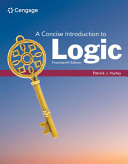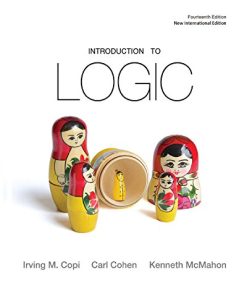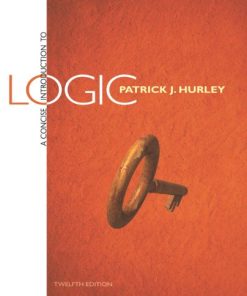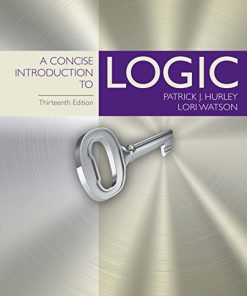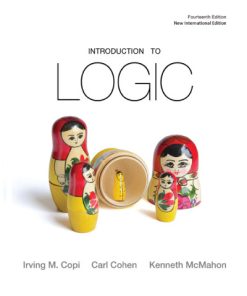(Ebook PDF) Consequence Relations An Introduction to the Lindenbaum Tarski Method 1st edition by Alex Citkin, Alexei Muravitsky 019269149X 9780192691491 full chapters
$50.00 Original price was: $50.00.$25.00Current price is: $25.00.
Consequence Relations: An Introduction to the Lindenbaum-Tarski Method 1st edition by Alex Citkin, Alexei Muravitsky – Ebook PDF Instant Download/DeliveryISBN: 019269149X, 9780192691491
Full download Consequence Relations: An Introduction to the Lindenbaum-Tarski Method 1st edition after payment.
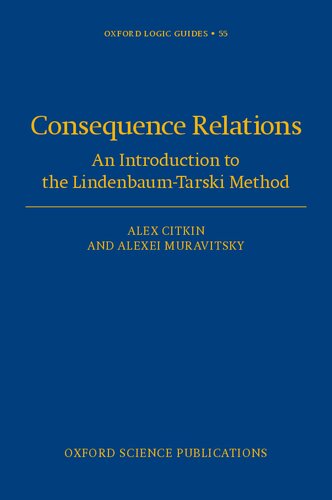
Product details:
ISBN-10 : 019269149X
ISBN-13 : 9780192691491
Author: Alex Citkin, Alexei Muravitsky
The publication of Rasiowa and Sikorski’s The Mathematics of Metamathematics (1970), Rasiowa’s An Algebraic Approach to Non-Classical Logics (1974), and Wójcicki’s Theory of Logical Calculi (1988) created a niche in the field of mathematical and philosophical logic. This in-depth study of the concept of a consequence relation, culminating in the concept of a Lindenbaum-Tarski algebra, fills this niche. Citkin and Muravitsky consider the problem of obtaining confirmation that a statement is a consequence of a set of statements as prerequisites, on the one hand, and the problem of demonstrating that such confirmation does not exist in the structure under consideration, on the other hand. For the second part of this problem, the concept of the Lindenbaum-Tarski algebra plays a key role, which becomes even more important when the considered consequence relation is placed in the context of decidability. This role is traced in the book for various formal objective languages. The work also includes helpful exercises to aid the reader’s assimilation of the book’s material. Intended for advanced undergraduate and graduate students in mathematics and philosophy, this book can be used to teach special courses in logic with an emphasis on algebraic methods, for self-study, and also as a reference work.
Consequence Relations: An Introduction to the Lindenbaum-Tarski Method 1st Table of contents:
1 Introduction
1.1 Overview of the key concepts
1.2 Overview of the contents
2 Preliminaries
2.1 Preliminaries from set theory
2.2 Preliminaries from topology
2.3 Preliminaries from algebra
2.3.1 Subalgebras, homomorphisms, direct products and subdirect products
2.3.2 Class operators
2.3.3 Term algebra, varieties and quasi-varieties
2.3.4 Hilbert algebras
2.3.5 Distributive lattices
2.3.6 Brouwerian semilattices
2.3.7 Relatively pseudo-complemented lattices
2.3.8 Boolean algebras
2.3.9 Heyting algebras
2.4 Preliminaries from model theory
2.5 Preliminaries from computability theory
2.5.1 Algorithmic functions and relations on N
2.5.2 Word sets and functions
2.5.3 Effectively denumerable sets
3 Sentential Formal Languages and Their Interpretation
3.1 Sentential formal languages
3.2 Semantics of sentential formal language
3.2.1 The logic of a two-valued matrix
3.2.2 The Lukasiewicz logic of a three-valued matrix
3.2.3 The Lukasiewicz modal logic of a three-valued matrix
3.2.4 The Gödel n-valued logics
3.2.5 The Dummett denumerable matrix
3.2.6 Two infinite generalizations of Lukasiewicz’s Ł3
3.3 Historical notes
4 Logical Consequence
4.1 Consequence relations
4.2 Consequence operators
4.3 Realizations of abstract logic
4.3.1 Defining new abstract logics from given ones by substitution
4.3.2 Consequence operator via a closure system
4.3.3 Defining abstract logic semantically: a general approach
4.3.4 Consequence relation via logical matrices
4.3.5 Consequence relation via inference rules
4.4 Abstract logics defined by modus rules
4.4.1 General characterization
4.4.2 Abstract logics 𝒮*
4.4.3 The class of 𝒮-models
4.4.4 Modus rules vs non-finitary rules
4.5 Extensions of abstract logics
4.6 Historical notes
5 Matrix Consequence
5.1 Single-matrix consequence
5.2 Finitary matrix consequence
5.3 The conception of separating tools
5.4 Historical notes
6 Unital Abstract Logics
6.1 Unital algebraic expansions
6.2 Unital abstract logics
6.2.1 Definition and some properties
6.2.2 Some subclasses of unital logics
6.3 Lindenbaum-Tarski algebras
6.3.1 Definition and properties
6.3.2 Implicational unital logics
6.3.3 Examples of Lindenbaum-Tarski algebras
6.3.4 Rieger–Nishimura algebra
6.4 Examples of application of Lindenbaum-Tarski algebras
6.4.1 Glivenko’s theorem
6.4.2 Completeness
6.4.3 Admissible and derivable structural inference rules
6.4.4 Classes of algebras corresponding and fully corresponding to a calculus
6.5 An alternative approach to the concept of Lindenbaum-Tarski algebra
6.6 Historical notes
7 Equational Consequence
7.1 Language for equalities and its semantics
7.2 Equational consequence
7.3 ℰˆ as a deductive system
7.4 Lindenbaum-Tarski matrices for logic ℰ
7.5 Mal’cev matrices
7.6 Equational consequence based on implicational logic
7.6.1 Abstract logic ℰB
7.6.2 Abstract logic ℰH
7.7 Philosophical and historical notes
8 Equational L-Consequence
8.1 Equational L-consequence
8.2 ℰˆL as a deductive system
8.3 Lindenbaum-Tarski matrices for logic ℰL
8.4 Interconnection between ℰ and ℰL
8.5 ℰL-models
8.6 Examples of logics ℰL
8.7 L-equational consequence based on implicational logic
8.8 Historical notes
9 𝒬 -Consequence
9.1 𝒬 -Languages
9.2 Semantics of ℒ𝒬
9.3 𝒬-Consequence
9.3.1 𝒬-consequence defined by 𝒬-matrices
9.3.2 𝒬-consequence defined via inference rules
9.4 Lindenbaum 𝒬-matrices
9.5 Lindenbaum-Tarski 𝒬-structures
9.6 Three 𝒬-matrix consequences
9.7 Historical notes
10 Decidability
10.1 Abstract logics defined by finite atlases
10.1.1 Indistinguishable formulas
10.1.2 Matrix equivalences
10.1.3 Restricted Lindenbaum matrices and atlases
10.2 Enumerating procedure
10.3 Solution to Problem (m.1)
10.4 Solution to Problem (m.2)
10.5 Solution to Problem (m.3)
10.6 Historical notes
People also search for Consequence Relations: An Introduction to the Lindenbaum-Tarski Method 1st:
jen the pen and consequence relationship
cause consequence relationship
antecedent consequence relationship
what is a common consequence of poor customer relations
what is the relationship between decision and consequence
You may also like…
Mathematics - Logic
Uncategorized
Uncategorized
Politics & Philosophy - International Relations
The Globalization of World Politics: An Introduction to International Relations 9th Edition
Uncategorized
Uncategorized
Politics & Philosophy




